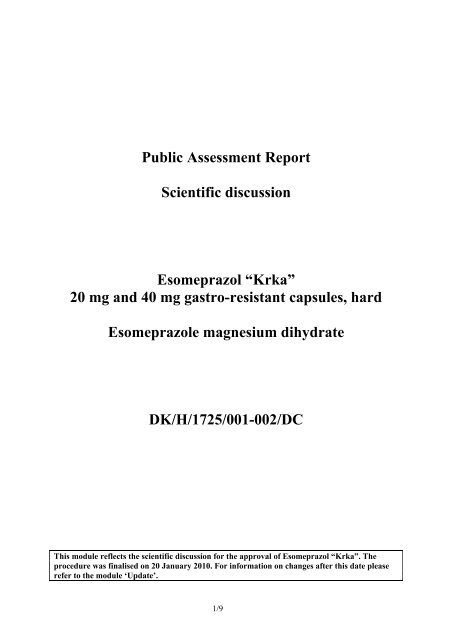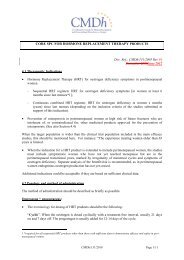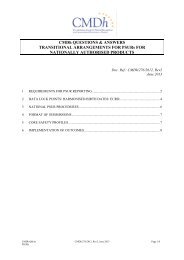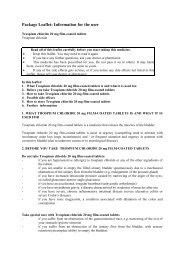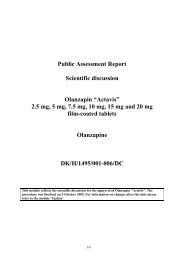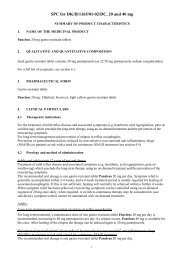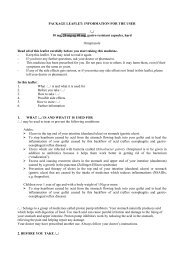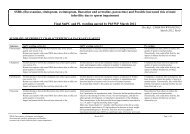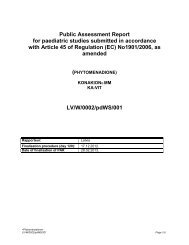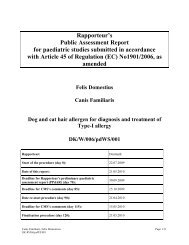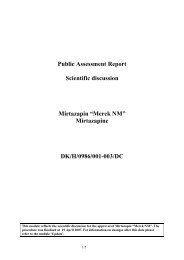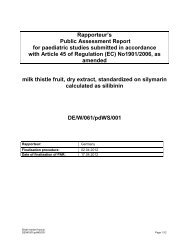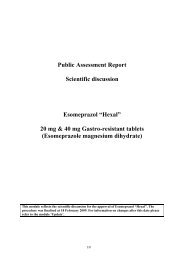Public Assessment Report Scientific discussion Esomeprazol “Krka ...
Public Assessment Report Scientific discussion Esomeprazol “Krka ...
Public Assessment Report Scientific discussion Esomeprazol “Krka ...
Create successful ePaper yourself
Turn your PDF publications into a flip-book with our unique Google optimized e-Paper software.
<strong>Public</strong> <strong>Assessment</strong> <strong>Report</strong><br />
<strong>Scientific</strong> <strong>discussion</strong><br />
<strong>Esomeprazol</strong> <strong>“Krka</strong>”<br />
20 mg and 40 mg gastro-resistant capsules, hard<br />
<strong>Esomeprazol</strong>e magnesium dihydrate<br />
DK/H/1725/001-002/DC<br />
This module reflects the scientific <strong>discussion</strong> for the approval of <strong>Esomeprazol</strong> <strong>“Krka</strong>”. The<br />
procedure was finalised on 20 January 2010. For information on changes after this date please<br />
refer to the module ‘Update’.<br />
1/9
I. INTRODUCTION<br />
Based on the review of the quality, safety and efficacy data, the Member States have granted a<br />
marketing authorisation for <strong>Esomeprazol</strong> <strong>“Krka</strong>” 20 mg and 40 mg gastro-resistant capsules, hard,<br />
from krka. The date of authorisation in Denmark was on 19 February 2010. The product is indicated<br />
for:<br />
• Gastroesophageal Reflux Disease (GERD):<br />
- Treatment of erosive reflux esophagitis.<br />
- Long-term management of patients with healed esophagitis to prevent relapse.<br />
- Symptomatic treatment of gastroesophageal reflux disease (GERD).<br />
• In combination with appropriate antibacterial therapeutic regimens for the eradication of<br />
Helicobacter pylori:<br />
- Healing of Helicobacter pylori associated duodenal ulcer.<br />
- Prevention of relapse of peptic ulcers in patients with Helicobacter pylori associated ulcers.<br />
• Patients requiring continued NSAID therapy:<br />
- Healing of gastric ulcers associated with NSAID therapy.<br />
- Prevention of gastric and duodenal ulcers associated with NSAID therapy, in patients at risk.<br />
• Prolonged treatment after i.v. induced prevention of rebleeding of peptic ulcers.<br />
• Treatment of Zollinger Ellison Syndrome.<br />
The weak base esomeprazole is the S-isomer of omeprazole and is concentrated and converted to the<br />
active form in the highly acidic environment of the secretory canaliculi of the parietal cell. The<br />
antisecretory substituted benzimidazole acts as a proton pump inhibitor capable of reducing both the<br />
basal and stimulated gastric acid secretion by suppressing H+ ion formation by specific inhibition of<br />
the gastric enzyme system proton pump (H+/K+-ATPase) at the secretory surface of the gastric parietal<br />
cell. Both the R- and S-isomer of omeprazole have similar pharmacodynamic activity.<br />
This decentralised procedure concerns a generic application claiming essential similarity with the<br />
reference product Nexium 20 mg and 40 mg gastro-resistant tablets, which has been registered in<br />
Sweden by AstraZeneca AB since 2000.<br />
The reference product marketed in Denmark is Nexium 20 mg and 40 mg gastro-resistant tablets,<br />
marketed by AstraZeneca A/S since 2000.<br />
The reference product used for BE studies is Nexium Mups 20 mg and 40 mg gastro-resistant tablets,<br />
AstraZeneca GmbH, marketed in Germany.<br />
The marketing authorisation is granted based on article 10.1 of Directive 2001/83/EC.<br />
II. QUALITY ASPECTS<br />
II.1 Introduction<br />
<strong>Esomeprazol</strong> <strong>“Krka</strong>” 20 mg and 40 mg gastro-resistant capsules, hard contains as active substance<br />
20 mg esomeprazole (as magnesium dihydrate) and 40 mg esomeprazole (as magnesium dihydrate),<br />
respectively.<br />
2/9
The body and the cap of the 20 mg capsules are slightly pink. The content of the 20 mg capsules are<br />
white to almost white pellets.<br />
The body and the cap of the 40 mg capsules are off-pink. The content of the 40 mg capsules are white<br />
to almost white pellets.<br />
<strong>Esomeprazol</strong> <strong>“Krka</strong>” is packed in blister packs (OPA-Al-PE + dessicant/Al + PE foil) in pack sizes of<br />
7, 14, 15, 28, 30, 50, 56, 60, 90, 98 and 100 gastro-resistant capsules, hard, in a box, and in HDPE<br />
tablet containers with PP closure with desiccant in pack sizes of 98 gastro-resistant capsules, hard, in a<br />
box.<br />
However, not all pack sizes may be marketed.<br />
The excipients in the capsule core (pellets) are: Sucrose; maize starch, povidone K30; sodium<br />
laurilsulfate; poly(vinyl alcohol); titanium dioxide (E171); macrogol 3000; macrogol 6000, talc; heavy<br />
magnesium carbonate; methacrylic acid – ethyl acrylate copolymer (1:1), dispersion 30%; and<br />
polysorbate 80<br />
The capsule shell consists of: Gelatin; titanium dioxide (E171); and red iron oxide (E172).<br />
Compliance with Good Manufacturing Practice<br />
The RMS has been assured that acceptable standards of GMP (see Directive 2003/94/EC) are in place<br />
for this product type at all sites responsible for the manufacturing of the active substance as well as for<br />
the manufacturing and assembly of this product prior to granting its national authorisation.<br />
II.2 Drug Substance<br />
The active substance esomeprazole magnesium dihydrate is not described in the European<br />
Pharmacopoeia; however there is an EP monograph on esomeprazole magnesium trihydrate.<br />
INN: <strong>Esomeprazol</strong>e<br />
Chemical names:<br />
5-Methoxy-2-[(S)-[(4-methoxy-3,5-dimethyl-2-pyridinyl)methyl]sulfinyl]-1H-benzimidazole<br />
magnesium dihydrate<br />
5-Methoxy-2-[(S)-[(4-methoxy-3,5-dimethyl-2-pyridinyl)methyl]sulfinyl]-1H-benzimidazole<br />
magnesium salt (2:1), dihydrate<br />
bis(5-Methoxy-2-[(S)-[(4-methoxy-3,5-dimethyl-2-pyridinyl)methyl]sulfinyl]-1Hbenzimidazole-1-yl)<br />
magnesium dihydrate<br />
Magnesium bis[5-methoxy-2-[(S)-[(4-methoxy-3,5-dimethyl-2-pyridinyl)methyl]sulfinyl]-1Hbenzimidazol-1-ide]<br />
dihydrate<br />
Other non-proprietary name: <strong>Esomeprazol</strong>e magnesium dihydrate<br />
Molecular formula: C34H36MgN6O6S2 . 2 H2O<br />
Molecular mass: 749.15 g/mol<br />
<strong>Esomeprazol</strong>e is a white to slightly coloured powder, which is slightly soluble in water, soluble in<br />
methanol and practically insoluble in heptane.<br />
<strong>Esomeprazol</strong>e is the S-isomer of omeprazole with a chiral center at the sulphur.<br />
The documentation on the active substance is presented as a European Drug Master File in CTD<br />
format and satisfactory letters of access are provided.<br />
3/9
The chemical-pharmaceutical documentation in relation to esomeprazole magnesium dihydrate is of<br />
sufficient quality in view of the present European regulatory requirements.<br />
The control tests and specifications for drug substance product are adequately drawn up.<br />
Stability studies have been performed on pilot scale batches of the drug substance. No significant<br />
changes in any parameters were observed. A suitable retest period has been set.<br />
II.3 Medicinal Product<br />
The product composition is adequately described. The development of the product has been<br />
satisfactorily performed and explained. The excipients used are commonly employed. The packaging<br />
materials are adequately described.<br />
Manufacture of gastro-resistant capsules is a non-standard process. Satisfactorily manufacturing<br />
process validation has been carried out on production scale batches of pellets and encapsulated<br />
product. Further data will be performed post-approval.<br />
The product specifications cover all appropriate parameters for this dosage form. Satisfactory<br />
validations of the analytical methods have been presented. Batch analysis has been performed on 6<br />
pilot batches; 3 of each strength. The batch analysis results show that the finished products meet the<br />
proposed specifications.<br />
Stability data covering up to 12 months data are provided for pilot scale batches stored in the proposed<br />
market packagings. The conditions used in the stability studies are according to the ICH stability<br />
guideline. The control tests and specifications for drug product are adequately drawn up.<br />
Based on the data submitted, a shelf-life of 2 years has been accepted for both strengths with the<br />
following storage conditions:<br />
Blister packs: Store in the original package in order to protect from moisture.<br />
Tablet containers: Keep the container tightly closed in order to protect from moisture.<br />
III. NON-CLINICAL ASPECTS<br />
This product is a generic formulation of Nexium gastro-resistant tablets, which is available on the<br />
European market. No new preclinical data have been submitted, and therefore the application has not<br />
undergone preclinical assessment. This is acceptable for this type of application<br />
Environmental risk assessment<br />
The product is intended as a substitute for other identical products on the market. The approval of this<br />
product will not result in an increase in the total quantity of esomeprazole released into the<br />
environment. It does not contain any component, which results in an additional hazard to the<br />
environment during storage, distribution, use and disposal.<br />
IV. CLINICAL ASPECTS<br />
IV.1 Introduction<br />
<strong>Esomeprazol</strong>e is a well-known active substance with established efficacy and tolerability.<br />
4/9
For this generic application, the MAH has submitted 3 bioequivalence studies in which the<br />
pharmacokinetic profile of the test product <strong>Esomeprazol</strong> <strong>“Krka</strong>” gastro-resistant capsules, hard is<br />
compared with the pharmacokinetic profile of the reference product Nexium Mups gastro-resistant<br />
tablets, AstraZeneca GmbH, marketed in Germany:<br />
• Single-dose study under fasting and fed conditions with the 40 mg strength<br />
• Single-dose study under fasting conditions with the 20 mg strength<br />
• Multiple-dose study under fasting conditions with the 40 mg strength<br />
Single-dose study under fasting and fed conditions – 40 mg<br />
The study was a single dose, randomized, three-way crossover bioavailability study conducted under<br />
fasting and fed conditions with a wash out period of 7 days between administrations. 40 mg was<br />
administered in each period.<br />
Fasting group: Blood samples were collected pre-dosing and at 0.50, 0.75, 1.0, 1.25, 1.5, 1.75, 2.0,<br />
2.25, 2.5, 2.75, 3, 3.5, 4.0, 4.5, 5, 6, 8, 10, 12 hours post administration of a single-dose 40 mg gastroresistant<br />
capsule or tablet with 240 ml of water for the analyses of esomeprazole in plasma.<br />
Fed group: Blood samples were collected pre-dosing and at 0.50, 1.0, 1.5, 2.0, 2.5, 3, 3.5, 4, 4.5, 5,<br />
5.5, 6, 6.5, 7, 7.5, 8, 10, 12, 14 hours post administration of a single-dose 40 mg gastro-resistant<br />
capsule or tablet with 240 ml of water for the analyses of esomeprazole in plasma.<br />
54 healthy Caucasian male subjects (18-55 years) participated in the study. 54 subjects completed the<br />
study. 1 to18 participated under fasting conditions and 19 to 54 under fed conditions.<br />
Drop-outs: 1 was excluded before the first dosing due to cigarette smoking. The subject was replaced<br />
by one of the reserve.<br />
Bioequivalence was concluded if the 90% geometric confidence intervals of the test/reference ratio of<br />
least-squares means for ln-transformed AUC0-∞, AUC0-t and Cmax were within the acceptable range of<br />
80-125%.<br />
Table 1. Pharmacokinetic parameters (non-transformed values; arithmetic mean ± SD, tmax (median<br />
range)) of esomeprazole under fasting conditions.<br />
Treatment<br />
(40 mg)<br />
N=18<br />
Test<br />
Reference<br />
*Ratio (90%<br />
CI)<br />
CV (%)<br />
AUC0-t<br />
ng.h/ml<br />
AUC0-∞<br />
ng.h/ml<br />
5/9<br />
Cmax<br />
ng/ml<br />
tmax<br />
2601.4±1440.7 2619.6±1462.8 1144.0±485.9 2.00<br />
(1.25-5.00)<br />
2469.8±1283.2 2483.4±1296.6 1055.8±404.9 2.25<br />
(1.25-3.00)<br />
103.66 103.75 107.15<br />
(94.89-113.24) (94.96-113.35) (97.90-117.28)<br />
15.3 15.3 15.6<br />
AUC0-∞ area under the plasma concentration-time curve from time zero to infinity<br />
AUC0-t area under the plasma concentration-time curve from time zero to t hours<br />
Cmax maximum plasma concentration<br />
tmax time for maximum concentration<br />
t1/2 half-life<br />
*ln-transformed values<br />
h<br />
t1/2<br />
h<br />
1.12±0.36<br />
1.09±0.31<br />
Table 2. Pharmacokinetic parameters (non-transformed values; arithmetic mean ± SD, tmax (median,<br />
range)) of esomeprazole under fed conditions.<br />
Treatment<br />
(40 mg)<br />
AUC0-t<br />
ng.h/ml<br />
AUC0-∞<br />
ng.h/ml<br />
Cmax<br />
ng/ml<br />
tmax<br />
h<br />
t1/2<br />
h
N=36<br />
Test<br />
Reference<br />
*Ratio (90%<br />
CI)<br />
CV (%)<br />
1954.5±1273.4 1990.9±1302.8 674.7±394.2 5.50<br />
(2.50-7.50)<br />
2114.1±1458.3 2134.1±1484.3 698.9±366.7 4.50<br />
(1.00-6.00)<br />
94.85 95.79 91.73<br />
(86.45-104.07) (87.51-104.86) (81.37-103.41)<br />
23.6 23.0 30.8<br />
AUC0-∞ area under the plasma concentration-time curve from time zero to infinity<br />
AUC0-t area under the plasma concentration-time curve from time zero to t hours<br />
Cmax maximum plasma concentration<br />
tmax time for maximum concentration<br />
t1/2 half-life<br />
*ln-transformed values<br />
6/9<br />
1.27±0.48<br />
1.13±0.44<br />
Single-dose study under fasting conditions – 20 mg<br />
The study was a randomized, two-period, two-sequence, two-way crossover, single-dose<br />
bioavailability study conducted under fasting conditions with a wash out period of 7 days between the<br />
two administrations. 20 mg was administered in each period.<br />
Blood samples were collected pre-dosing and at 0.50, 0.75, 1.0, 1.25, 1.5, 1.75, 2.0, 2.25, 2.5, 2.75, 3,<br />
3.5, 4.0, 4.5, 5, 6, 8, 10, 12 hours post administration of a single-dose 20 mg gastro-resistant capsule or<br />
tablet with 240 ml of water for the analyses of esomeprazole in plasma.<br />
36 healthy Caucasian male subjects (18-55 years) participated in the study. 35 subjects completed the<br />
study.<br />
Drop-outs: 1 was withdrawn due to illness during the wash-out period.<br />
The decision about bioequivalence between the test formulation vs. the reference formulation was<br />
based on the calculated 90% confidence intervals of Cmax, AUC0-t and AUC0-∞ pharmacokinetic<br />
parameters of esomeprazole, which should be within 80-125% acceptance range.<br />
Table 3. Pharmacokinetic parameters (non-transformed values; arithmetic mean ± SD, tmax (median,<br />
range)) of esomeprazole under fasting conditions.<br />
Treatment<br />
(20 mg)<br />
N=35<br />
Test<br />
Reference<br />
*Ratio (90%<br />
CI)<br />
CV (%)<br />
AUC0-t<br />
ng.h/ml<br />
AUC0-∞<br />
ng.h/ml<br />
Cmax<br />
ng/ml<br />
tmax<br />
1027.1±612.0 1037.1±621.5 531.5±169.4 1.75<br />
(1.00-3.50)<br />
1042.0±629.9 1052.0±641.5 560.3±184.6 1.25<br />
(0.75-2.50)<br />
98.62 98.64 94.86<br />
(92.81-104.79) (92.87-104.77) (87.30-103.08)<br />
15.1 15.0 20.8<br />
AUC0-∞ area under the plasma concentration-time curve from time zero to infinity<br />
AUC0-t area under the plasma concentration-time curve from time zero to t hours<br />
Cmax maximum plasma concentration<br />
tmax time for maximum concentration<br />
t1/2 half-life<br />
*ln-transformed values<br />
Steady-state study conducted under fasting conditions – 40 mg<br />
h<br />
t1/2<br />
h<br />
0.96±0.38<br />
0.97±0.37
The study was an open-label, randomized, two-treatment, two-sequence, two-period, two-way<br />
crossover, multiple dose bioavailability study (one daily dosage for 7 consecutive days) conducted<br />
under fasting conditions with no a wash out period between the two administrations phases. 40 mg<br />
was administered daily in each period.<br />
Blood samples were collected pre-dosing on days 1, 5, 6, 7, 12, 13, and 14 and at 0.50, 0.75, 1.00,<br />
1.25, 1.50, 1.75, 2.00, 2.25, 2.50, 2.75, 3.00, 3.50, 4.00, 4.50, 5.00, 6.00, 8.00, 10.0, 12.0 and 24.0<br />
hours post administration on days 7 and 14 of a single-dose daily of 40 mg capsules with 240 ml of<br />
water for the analyses of esomeprazole.<br />
36 healthy Caucasian male subjects (18-50 years) participated in the study. 36 subjects completed the<br />
study.<br />
Bioequivalence was concluded if the 90% intervals of the ratios of LSM derived from analysis on the<br />
ln-transformed PK parameters AUC0-t, AUCinf and Cmax for esomeprazole in plasma were within the<br />
80-125% acceptance range.<br />
Table 4. Pharmacokinetic parameters (non-transformed values; arithmetic mean ± SD, tmax (median,<br />
range)) of esomeprazole under fasting conditions in steady state.<br />
Treatment<br />
(40 mg)<br />
N=36<br />
Test<br />
Reference<br />
*Ratio (90%<br />
CI)<br />
CV (%)<br />
AUC0-t<br />
ng.h/ml<br />
AUC0-∞<br />
ng.h/ml<br />
7/9<br />
Cmax<br />
ng/ml<br />
tmax<br />
4280.2±1492.6 4325.1±1537.2 1649.6±447.6 1.75<br />
(1.00-3.50)<br />
4337.8±1451.8 4389.0±1492.3 1484.9±305.5 1.75<br />
(0.75-3.00)<br />
98.43 98.27 109.61<br />
(94.52-102.51) (94.39-102.32) (102.92-<br />
116.73)<br />
10.2 10.1 15.9<br />
AUC0-∞ area under the plasma concentration-time curve from time zero to infinity<br />
AUC0-t area under the plasma concentration-time curve from time zero to t hours<br />
Cmax maximum plasma concentration<br />
tmax time for maximum concentration<br />
t1/2 half-life<br />
*ln-transformed values<br />
h<br />
t1/2<br />
h<br />
1.48±0.46<br />
1.48±0.42<br />
The 90% confidence intervals calculated for AUC0-t, AUC0-∞ and Cmax are within the bioequivalence<br />
acceptance range of 0.80 – 1.25.<br />
Based on the submitted bioequivalence studies <strong>Esomeprazol</strong> <strong>“Krka</strong>” gastro-resistant capsules, hard are<br />
considered bioequivalent with Nexium Mups gastro-resistant tablets by AstraZeneca under fed and<br />
fasting conditions.<br />
The RMS has been assured that the bioequivalence study has been conducted in accordance with<br />
acceptable standards of Good Clinical Practice (GCP, see Directive 2005/28/EC) and Good<br />
Laboratory Practice (GLP, see Directives 2004/9/EC and 2004/10/EC).<br />
IV.2 Risk management plan & Pharmacovigilance system<br />
<strong>Esomeprazol</strong>e was first approved in 2000, and there is now extensive experience with the active<br />
substance. The safety profile of esomeprazole can be considered to be well established and no product<br />
specific pharmacovigilance issues were identified pre- or postauthorisation which are not adequately<br />
covered by the current SPC. Additional risk minimisation activities have not been identified for the
eference medicinal product. The MAH has a pharmacovigilance system at their disposal, which is<br />
based on the current European legislation.<br />
The Pharmacovigilance system described fulfils the requirements and provides adequate evidence that<br />
the applicant has the services of a qualified person responsible for pharmacovigilance and has the<br />
necessary means for the identification and notification of any a potential risks occurring either in the<br />
Community or in a third country.<br />
V. PRODUCT INFORMATION<br />
SmPC and Package leaflet<br />
The content of the SmPC and package leaflet approved during the decentralised procedure is in<br />
accordance with that accepted for the reference product Nexium marketed by AstraZeneca.<br />
Readability test<br />
The package leaflet has been evaluated via a user consultation study in accordance with the<br />
requirements of Articles 59(3) and 61(1) of Directive 2001/83/EC. The language used for the purpose<br />
of user testing the package leaflet was English. The test consisted of a pilot test with 2 participants,<br />
followed by two rounds with 10 participants each. The questions covered the following areas<br />
sufficiently: traceability, comprehensibility and applicability. The readability test has been sufficiently<br />
performed.<br />
The results show that the package leaflet meets the criteria for readability as set out in the Guideline<br />
on the readability of the label and package leaflet of medicinal products for human use.<br />
VI. OVERALL CONCLUSION, BENEFIT/RISK ASSESSMENT AND<br />
RECOMMENDATION<br />
<strong>Esomeprazol</strong> <strong>“Krka</strong>” 20 mg and 40 mg gastro-resistant capsules, hard has a proven chemicalpharmaceutical<br />
quality and is a generic form of Nexium gastro-resistant tablets. Nexium is a wellknown<br />
medicinal product with an established favourable efficacy and safety profile.<br />
Bioequivalence has been shown to be in compliance with the requirements of European guidance<br />
documents.<br />
The MAH has provided written confirmation that systems and services are in place to ensure<br />
compliance with their pharmacovigilance obligations.<br />
The SmPC, package leaflet and labelling are in the agreed templates and are in agreement with other<br />
esomeprazole containing products.<br />
Agreement between Member States was reached during a written procedure. There was no <strong>discussion</strong><br />
in the CMD(h). The Concerned Member States, on the basis of the data submitted, considered that<br />
essential similarity has been demonstrated for <strong>Esomeprazol</strong> <strong>“Krka</strong>” with the reference product, and<br />
have therefore granted a marketing authorisation. The decentralised procedure was finished on 20<br />
January 2010. <strong>Esomeprazol</strong> <strong>“Krka</strong>” was authorised in Denmark on 19 February 2010.<br />
A European harmonised birth date has been allocated (2000-03-10) and subsequently the first data<br />
lock point for esomeprazole is 2006-03. The first PSUR will be submitted with the DLP of 2011-03,<br />
after which the PSUR submission cycle is 3 years.<br />
The date for the first renewal will be: 20 January 2015.<br />
8/9
The following post-approval commitments have been made during the procedure:<br />
• The sampling point (45 minutes) for dissolution at pH 6.8 in the finished product specifications<br />
should be reviewed when more experience is gained from data collected after 30 minutes.<br />
• The enclosed stability studies for both active substance (2 years) and finished products (2 years)<br />
will be continued. Results from these studies will be submitted to the RMS and CMS when<br />
finalised.<br />
• The certificates for the third production batch of each strength (20 mg and 40 mg) will be added<br />
as soon as the batch is manufactured.<br />
• Third production scale batch of maximum batch size (pellets and capsules) will be validated<br />
when manufactured.<br />
• The first 3 production batches of each strength will be put on stability and tested according to<br />
the stability protocol as presented in section P.8.1.<br />
• Updated pages of module 3.2.S.2.3 in the Restricted part of the EDMF should be provided no<br />
later than 1 April 2010.<br />
9/9


